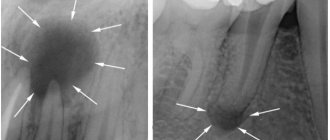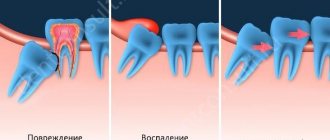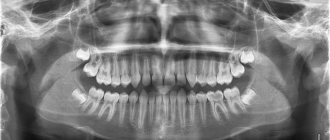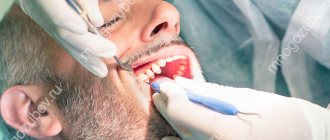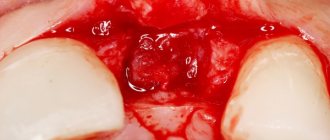Date of publication: 09.24.2018
A dental cyst is a sac in the bone tissue filled with pus. At the early stage of its appearance, a person experiences only pain when pressed. Lack of treatment aggravates the situation and after some time the symptoms change:
- - Constant pain appears;
- - Swelling around the tooth;
- — Increased temperature;
- — Flux;
- - Active formation of pus.
In this case, you urgently need to consult a doctor.
Tooth cyst: symptoms
Most often, the neoplasm at the root apex does not manifest itself in any way; only sometimes, with certain pressure, a slight pain syndrome is felt, and darkening or displacement of the tooth may also occur. An x-ray can accidentally detect a cyst, which is often done to treat adjacent roots. The symptomatic picture of the presence of a dental cyst is determined by the stage of inflammation. When the immune system is weakened, the tumor begins to grow and purulent processes appear. This leads to severe pain, swelling and fistula formation. At this stage, the following symptoms of the development of the inflammatory process in the oral cavity are distinguished:
- Enlarged lymph nodes.
- Weakness, general malaise of the body.
- Headache.
- Increase in body temperature.
The appearance of these symptoms is a reason to immediately contact a dentist. Photo of a dental cyst.
Development mechanism
A cyst is a tumor-like disease and is found quite often in dentistry. It appears in the form of a small ball with a dense connective tissue membrane. It occurs as a result of an infection, the development of which leads to the destruction of the dental or bone tissue of the jaw. The infection spreads very quickly and the body, in order to protect itself and prevent further destruction, surrounds the lesion with a capsule, thus protecting healthy tissues from infection. As a result, a cavity with purulent contents is formed.
All of the above processes take a very long time to occur, and therefore the disease does not manifest itself immediately. The main symptoms usually appear when the cyst becomes inflamed or filled with pus. And to get rid of it, a fistula tract is formed. It can appear both on the gum and on the cheek. It is through this passage that the pus comes out.
Reasons for the formation of a cyst on a tooth
A cyst on a tooth is formed due to infection of the root canals, which can lead to:
- Caries and pulpitis that were not cured in a timely manner or did not undergo the final stage of treatment.
- Poor quality root canal filling.
Lack of treatment for caries leads to the development of pulpitis. If the inflamed pulp was not removed in time, the infection through the root canals spreads beyond the boundaries of the tooth. The same thing happens when poor-quality root canal filling is performed. If the filling was not completed to the top of the root, then an inflammatory process begins to develop in the untreated area, which subsequently leads to the appearance of a cyst. Poor quality filling is fraught with the development of pathology.
What is stomatitis, symptoms, causes
Stomatitis
- an extremely unpleasant sore, and its unpleasantness lies in the fact that it is very painful. The pain is especially severe when eating or drinking drinks. Every piece of cake, every spoonful of porridge and every sip of juice will only cause discomfort and discomfort, let alone hot tea or cold ice cream. Remember, if you have stomatitis, you will remain without pleasure when eating for a long time.
In scientific terms, stomatitis is a lesion of the oral mucosa that occurs as a result of poor hygiene or trauma to the surface, which is accompanied by the appearance of white (often with pus) erosions or ulcers on the palate, tongue, under the tongue, on the inner surfaces of the cheeks and lips. The disease is accompanied by burning, itching, and painful sensations when eating and drinking.
It is very easy to recognize this disease, because its symptoms are quite specific.
So, the most popular symptoms of stomatitis:
- Uncomfortable dry mouth.
This symptom is the first and is often missed, as it can signal other problems, including thirst or a hangover.
- Whitish-gray coating.
It forms approximately three days after the body is infected. Places of dislocation are the tongue, the inner surfaces of the lips and cheeks, the tongue, and at the very end - the corners of the lips. This is already a sure sign of the disease, it is difficult to miss it, so it’s time to start treatment (which is best planned according to the doctor’s recommendations).
- Erosions, ulcers.
These are quite painful formations that appear at the site of the plaque if therapy is not started on time. They look like swellings covered with a whitish coating. In some cases, purulent deposits may form inside these sores.
- Malignant tumors.
A rather rare, but still occurring complication of stomatitis, which is better known to us under the terrible name cancer. If you do not want ordinary plaque to lead to such complications, monitor the condition of your oral cavity, thoroughly brush and rinse your teeth (and regularly, which is important) and respond in a timely manner to the slightest changes in the oral mucosa.
Once again, we emphasize that this disease is infectious, and therefore can be transmitted from carrier to carrier. Its causative agent is a microbe that can develop as a result of the following reasons:
- Insufficient or irregular oral hygiene.
- Injury to the mucous membrane (abrasions that sometimes occur due to using a toothbrush that is too hard, scratches, punctures, burns).
- Allergic reaction to food, medications and other substances.
- Immunodeficiency conditions, immune weakness.
- Wearing dentures or orthodontic appliances (common in older people and children).
- Contact with a sick person.
Prevention of stomatitis
This includes careful and regular oral hygiene, eating warm food and drinks, but not hot or too cold, using a suitable soft-fiber or medium-hard toothbrush, and proper care of dentures or orthodontic preparations. It is also necessary to avoid contact with carriers of the infection. This is especially true if you are susceptible to herpes. Stomatitis in combination with a herpes infection is a dangerous mixture that needs to be seriously dealt with under the guidance of a doctor.
Choice of treatment method
Experts use 2 approaches to treating dental tumors:
- Therapeutic.
- Surgical.
Therapeutic techniques will be relevant in the following cases:
- If there is no need to unseal the root canals.
- In case of poor-quality filling of root canals along the entire length.
- When the size of the cyst is more than 1 cm and regular exacerbations of the inflammatory process: the appearance of pain, swelling of the gums, etc.
The choice of surgical technique is based on:
- The presence of pins in the root canal and a dental crown.
- High-quality filling of root canals (more than half, while slight underfilling of the canals at the apex of the tooth root is allowed).
- The formation of a cyst with a diameter of more than 1 cm, which is accompanied by constant pain and swelling of the gums.
Features of the therapeutic approach
Therapeutic treatment is quite long and consists of the following stages:
- Treatment of root canals: removal of pulp (if they are not filled), unfilling (if they were filled).
- Antiseptic root canal cleaning.
- Injection of an antiseptic directly into the cavity of the dental cyst.
- Filling canals with paste with an antiseptic effect.
- Placing an antiseptic into the cyst cavity and antiseptic cleaning of the root canals are performed for several months at each visit to the dentist.
- If the x-ray shows a decrease in the diameter of the cyst, then the therapeutic approach is effective.
- Final filling of root canals.
- Installation of a seal.
After treatment, the patient needs to have an x-ray every few months to assess the condition of the cyst under the tooth. The dynamics should be as follows: reduction in the size of the cyst and restoration of bone tissue. Statistics show that therapeutic treatment gives a positive result in 70% of patients.
Tooth cyst: surgical treatment
In some cases, treatment of a dental cyst will be most effective with surgery. After therapeutic treatment of a tooth, the cyst may not resolve, so to solve this problem the patient needs to visit a dental surgeon. It should be understood that for a quality diagnosis, it is important to differentiate a real dental cyst from a granuloma, which is treated by effective endodontic canal therapy. But the structure of the tumor is determined by histology - and therefore, after surgical intervention. In order not to prescribe operations for all patients, if a cyst is suspected, dentists use the following algorithm of actions:
- An X-ray of the oral cavity is taken (sometimes a CT scan is required), which determines the area where the neoplasm is present and the presence of a connection with the root system of the tooth.
- If no connection between the cyst and the roots of the teeth is detected, the patient is sent to a dental surgeon for canal treatment, the quality of which is influenced by the use of a dental microscope.
- It is necessary to treat the canals using special tools and preparations, treat the dental cyst with a laser, and use ozone therapy techniques.
- After this, careful filling of the root canals should be performed, which will avoid the development of complications.
- The patient goes home. If within six months after treatment there are no signs of relapse, then it was a granuloma. There is no need for further surgery.
- If the inflammatory process does not stop, then it is necessary to remove the tooth tumor.
Effective alternative medicine
As mentioned above, the use of traditional methods must be combined with taking medications, but this must be done correctly. Therefore, if a cyst appears in the gum, treatment at home should only occur after prior consultation with a specialist. He will tell you which folk remedies will be most effective in your case and how to use them correctly.
Salt mouthwash
You can get rid of a cyst using saline solutions. They have numerous medicinal properties, including:
- Aseptic.
- Anti-inflammatory.
- Painkillers.
- Antibacterial.
- Wound healing.
All these qualities of saline solutions make it possible to relieve inflammation and purulent processes in the cyst without drugs. They are prepared simply: take a glass of chilled boiled water, in which 0.5 tsp is stirred. finely ground table or sea salt. You need to rinse your mouth with the resulting solution every 1.5 hours until the signs of the cyst completely disappear.
Herbal infusion
Treatment of cystic formations on the gums at home can also be done with the help of medicinal infusions. To prepare them, you can use herbs, for example:
- chamomile;
- calendula;
- yarrow;
- sage;
- eucalyptus.
All these plants have a powerful antibacterial effect and make it possible to eliminate the purulent processes occurring in the cyst, even in the later stages of the disease. Infusions are used to rinse the mouth. To prepare them, take any herb mentioned above in the amount of 2 tbsp. l., pour a glass of boiling water and infuse in a thermos for 10 hours.
After this, the infusion is filtered, diluted with chilled warm water in a ratio of 1:10 and rinsed with it 3-4 times a day.
Alcohol tinctures
When a cyst appears, treatment can also be carried out using alcohol tinctures. They have a disinfecting effect, prevent the spread of infectious and purulent processes, as well as the development of sepsis and abscess. The most effective in this regard are tinctures based on horseradish and ficus.
To prepare the first tincture, you need to take a three-liter bottle, fill it halfway with finely grated horseradish root and fill it to the top with vodka or medical alcohol. You need to infuse the product for at least 3 days in a cool place. After this, strain it.
To prepare the second tincture, you will need 30 - 50 ficus leaves, which must be crushed and poured into 1 liter of vodka. Place the resulting mixture in a cool, dark place for a week, and then strain.
These tinctures are used as a mouth rinse. To do this, they are diluted in half with water. Therapeutic measures need to be carried out at least 3 times a day.
Sesame oil
You can also treat cysts at home using sesame oil. It has the following properties:
- Anti-inflammatory.
- Aseptic.
- Antibacterial.
In addition, the oil saturates the gums with useful micro- and macroelements, which ensures the restoration of metabolic processes in them and accelerates the regeneration of damaged tissues.
Treatment with sesame oil is as follows: oil in the amount of 1 tbsp. l. hold in the mouth for 10 - 15 minutes, then spit out. These manipulations are carried out 5 – 6 times a day. After them, it is not recommended to drink or eat food for 30 minutes.
Garlic
Garlic has a powerful antibacterial effect, and therefore is suitable for treating festering cysts in the oral cavity. It is used in several ways:
- Rub the gums in the projection of the location of the cyst 3 – 5 times a day.
- Apply garlic pulp to the site of inflammation and keep it in the mouth until completely absorbed 2 - 3 times a day.
You should not use garlic too often, as this can cause gum irritation and other unpleasant symptoms. To prevent this, after medical procedures, it is recommended to rinse your mouth with herbal infusions or vegetable oil.
Clove oil
Clove oil has also proven itself in treatment. It perfectly relieves inflammatory processes, prevents the development of infection and provides pain relief. It is used as compresses, which are placed on the gums 2–3 times. To do this, soak a small piece of gauze in oil and apply it to the cyst for 15–20 minutes.
Lemon
Lemon contains a lot of vitamin C, which is necessary to improve immunity, as well as other beneficial substances that relieve inflammatory processes and improve the regeneration of damaged tissues.
It is used as follows: squeeze the juice from ½ lemon and dilute 1:1 with chilled boiled water. Rinse the mouth with the resulting solution every 2 hours.
It is necessary to understand that alternative medicine does not help to completely get rid of the cyst. Their use can only reduce the clinical manifestations of the disease and prevent the development of complications. Only surgery will help cure the cyst and forget about it once and for all.
Alternative treatment for dental cysts
Another method of treatment is used if root canal treatment does not give the desired result. Apical surgery is also relevant for the treatment of anterior tooth cysts, since the bones in the frontal zone are not as thick as in the area of the posterior roots. The technique involves removing the contents of the cyst and the infected area of the tooth root. After this, the specialist fills the tooth from the inside and sews up the incision. If apical surgery did not allow the patient to forget about the problem, and after the treatment another cyst has formed, the tooth must be completely removed, and then it is recommended to install an implant in its place. Thus, modern dentistry is aimed at carrying out tooth-preserving procedures (even in the presence of a wisdom tooth cyst), and only if they are ineffective is removal of the pathological root and an expensive procedure - implantation. Remember, traditional medicine is not able to stop the development of the inflammatory process - even the strongest drugs from the group of antibiotics and antiseptics cannot cope with this. Therefore, the only method to solve the problem is to remove all affected areas, as well as high-quality treatment and filling of the root canals.
Types of dental cysts
Depending on the factors that caused the pathology, the following types of cysts are distinguished:
- radicular;
- residual;
- retromolar (paradental);
- follicular;
- eruption cyst;
- keratocyst.
Radicular cyst
This type is the most common and is a consequence of complications of periodontitis. Such a cyst is localized in the area of the tooth root. At an early stage it is a granuloma and does not cause concern.
Cysts formed due to improper teething
Most types of cysts - eruption, keratocyst, retromolar and follicular - are the result of improper teething or developmental defects at different ages.
- Retromolar cyst is a complication during the eruption of wisdom teeth.
- Follicular cyst - appears under the crown of an unerupted tooth.
- Eruption cysts are formed during the eruption of permanent teeth in children 7-10 years old and resolve on their own.
- A keratocyst can form in infants when the process of eruption of baby teeth is disrupted.
Residual cyst
This type of cyst is formed when a tooth is removed incorrectly, for example, when unremoved parts of the root remain. Residual cysts are more difficult than others to treat and diagnose; they are fraught with relapses due to their incomplete removal.
Possible complications
If the cyst is not diagnosed and treated in a timely manner, this is fraught with the following consequences:
- Increased pain while chewing food.
- The appearance of swelling.
- Development of periostitis.
- Transition to the stage of purulent inflammation to such a degree that there is a danger of threatening the patient’s life.
- Most patients find out that they have a dental cyst only when severe pain begins. Regular preventive examinations at the dentist allow you to promptly detect the presence of a tumor and begin adequate treatment.
To prevent the development of tumors, it is necessary to visit the dentist every six months to heal caries. You should not bring your condition to such an extent that it becomes impossible to endure the pain of a dental cyst.
Therapy without removal
If this formation was detected in the early stages of development, the dentist may suggest drug therapy. This is possible if a new formation of connective tissue has appeared on the root of the tooth, but has not yet filled with fluid. It's called a granuloma. You can try to get rid of it without surgery. This is what it looks like:
- During a visit to the dentist, a canal is opened to get to the growth on the root of the tooth.
- All channels and cavities are well cleaned.
- The doctor will definitely add medicine to prevent further growth of bacteria.
- A temporary filling is placed on top to prevent the medication from falling out and to prevent food particles and liquids from getting inside.
Therapy does not end with this visit. The doctor will most often prescribe a course of antibacterial drugs to relieve the inflammatory process. You will need to visit your doctor periodically to monitor the progress of the treatment process.
If the dentist sees that the cyst is gradually resolving and decreasing in size, then the therapy is successful. Otherwise, the question will arise: is it possible to cure a dental cyst without removal?
Removal of a tooth cyst: price
The cost of cyst treatment is determined at an appointment with the dentist after a detailed examination of the oral cavity and additional diagnostic procedures. Treatment prices depend on the size of the cyst, the number of root canals in the tooth and the degree of complexity of the inflammatory process that has arisen. The type of structure being installed is also important: fillings, inlays or crowns. In our Dental Guru clinic, treatment of dental cysts, the price of which is in the affordable segment, is performed by qualified dentists with many years of experience. We guarantee a positive result from the therapeutic or surgical treatment provided the patient follows all the recommendations of the Dental Guru dentists.


